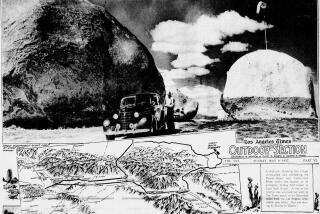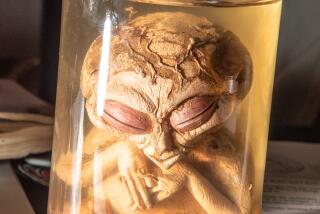Net Fiction
Of course the Mr. Gorsky story is untrue. This is beside the point. At this moment, it is circling the globe with a speed that would have seemed magical back when our ancestors were swapping gossip around the village well.
The Mr. Gorsky story is a “Netmyth.” That is, it’s circulating on the Internet, and it’s an urban legend--a terrifically entertaining story presented as fact even though it isn’t. Netmyths are of great interest to sociologists and computer experts, who say they are creating new rules about distinguishing between truth and fiction.
But first, the Mr. Gorsky story--currently a hot item on computer screens at NASA’s Goddard Space Flight Center. It goes like this:
When Apollo astronaut Neil Armstrong walked on the moon, he made an enigmatic remark: “Good luck, Mr. Gorsky.” The comment was captured on the radio communications between the spacecraft and Mission Control but was not heard by the public. At the time, NASA folks assumed Armstrong was referring to some rival Soviet cosmonaut, but there was no Gorsky in the Soviet space program. Armstrong refused to explain the remark, which over time attained cult status among space program cognoscenti.
In July, the story continues, Armstrong made a speech in Tampa Bay, where the perennial Mr. Gorsky question came up. This time, Armstrong said he could answer, since Mr. Gorsky was now dead.
As a kid, Armstrong said, he lived next door to the Gorskys. One day he and his brother were playing ball in the backyard when his brother hit a pop fly that landed in the Gorskys’ backyard, right outside their bedroom window. As Armstrong leaned over to pick up the ball, he heard an irate Mrs. Gorsky yelling at her husband, “Oral sex? Oral sex you want? You’ll get oral sex when the kid next door walks on the moon!”
Brian Welch, NASA’s news chief, first heard the Mr. Gorsky story last fall. Since then, he says, he’s gotten three or four calls on it, all of them from people who have seen the story on the Internet. Welch had a friend at Johnson Space Flight Center go through the old Apollo 11 transcripts, which--big surprise--contain no reference to a Mr. Gorsky, he says.
And yet, Welch says, “This is something I’m going to get asked about as long as I work for NASA.” When it comes to urban myths on the Internet, he adds, “You wonder how well people are able to discern the real from the not real in that medium.”
That is indeed the question. Netmyths differ from traditional urban myths in several important ways, say scientists and computer experts. Traditional urban myths get told and retold: The story about the microwaved poodle, for example, or the one about the American tourists in Mexico who buy a Chihuahua and find out it’s a sewer rat, come in dozens of variations.
But Netmyths explode instantly around the globe, duplicated word-for-word with the click of a computer mouse.
Urban myths that get on the Internet benefit from a subtly enhanced credibility, says Robert Park, a University of Maryland physics professor and an authority on pseudo-science.
“Rightly or wrongly, people have always assumed that which is printed has more credibility than that which is not,” he says. “With the Internet, there’s an enormous amount of information that hasn’t been filtered through anything. It didn’t have to find a publisher; it didn’t have to go through any peer review to become available to enormous numbers of people.”
That creates a data flow that bypasses institutions that have traditionally vetted the news--such as newspapers or scientific publications like the New England Journal of Medicine. When it comes to evaluating information in this brave new world, it’s every man for himself.
But the Internet is an adaptable medium. Already, there are several newsgroups devoted to debunking all kinds of urban legends. If you browse through alt.folklore.urban, you can learn that Jamie Lee Curtis is not a hermaphrodite and that Albert Einstein did not do poorly in school; also that some people do indeed sneeze when exposed to bright light, and that fluorescent lamps will light up when held near a high-voltage line.
*
Debunking Netmyths isn’t always easy. Some come with an impressive, if Dave Barry-ish, aura of authenticity. For example, the Darwin Award story.
The Darwin Award, presented as a mordant take on real life, is supposedly given each year to the person who does the human gene pool a favor by eliminating himself in the dumbest possible way.
The 1994 award supposedly went to the person responsible for the pile of smoldering metal some Arizona Highway Patrol officers found embedded in the side of a cliff in the desert, at a point where the road curved. The smoldering metal turned out to be the remains of a car.
The Arizona crime lab, the story goes, figured out how it all happened: Somebody had gotten hold of a JATO, or jet-assisted takeoff unit, also known as a solid fuel rocket. This person had driven his Chevrolet Impala out into the desert, attached the JATO units to the back of his car, and fired that baby up. When he hit the curve, the crime lab estimated, he was going between 250 and 300 mph, a speed at which the ordinary Chevrolet Impala becomes a little hard to steer. The Chevy’s brakes were completely burned away, according to the crime lab, indicating the driver may have had second thoughts about his experiment. Too late: Car meets cliff.
Yet despite the reference to the “Arizona State Patrol” and the authentic-sounding reference to JATO units, this story is not true. That’s according to a spokesman for the Arizona Department of Public Safety, who should know.
“We get a call on that about every 90 days,” says Sgt. Dave Myers. “It keeps us on the map.”
*
It’s impossible to keep track of all the Netmyths out there. There is, for instance, a very authentic-looking NASA memo that purportedly details a secret experiment on the logistics of having sex in space; also untrue, the space agency’s Welch says. Then there’s the “Most Bizarre Suicide of 1994” story, supposedly recounted at the 1994 awards dinner for a group called the American Assn. for Forensic Science.
According to this story, a man jumps from the 10th floor of a building, intending to commit suicide. On his way down, he is killed by a blast from a shotgun fired out a window on the ninth floor. Which was unlucky--or lucky, depending on your point of view--because a safety net had been erected below, and the would-be suicide’s original plan would have failed. But. . . .
The shooter on the ninth floor was an old man arguing with his wife, who said he often threatened her with the shotgun but said it was never loaded. Unbeknown to the old man, it was loaded--some six weeks earlier, by the couple’s son, who was mad at his mother for disinheriting him and was hoping to trick his father into killing her. As the weeks went by, the son became despondent over the failure of his plan and became the man who tried to commit suicide by jumping from the building’s 10th floor.
This farfetched tale is apparently bizarre enough to convince a few people that it is true, judging from the comments appended to it by Internet browsers. But unlike most Netmyths, it can be tracked to its author: one Don Harper Mills, past president of a real organization called the American Academy of Forensic Sciences.
“I made it up,” Mills says proudly when asked about the truth of the tale. Only it wasn’t in 1994. It was part of a speech he gave at the group’s 1987 banquet, he says, and he did it strictly for entertainment.
“I didn’t expect it to get on the Internet,” he says. So far, he’s gotten more than 100 calls about it. Does this surprise him?
“No, not really,” he says. “It’s a fabulous story.”
More to Read
Sign up for Essential California
The most important California stories and recommendations in your inbox every morning.
You may occasionally receive promotional content from the Los Angeles Times.










